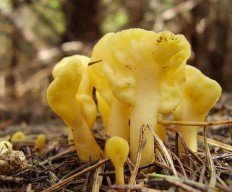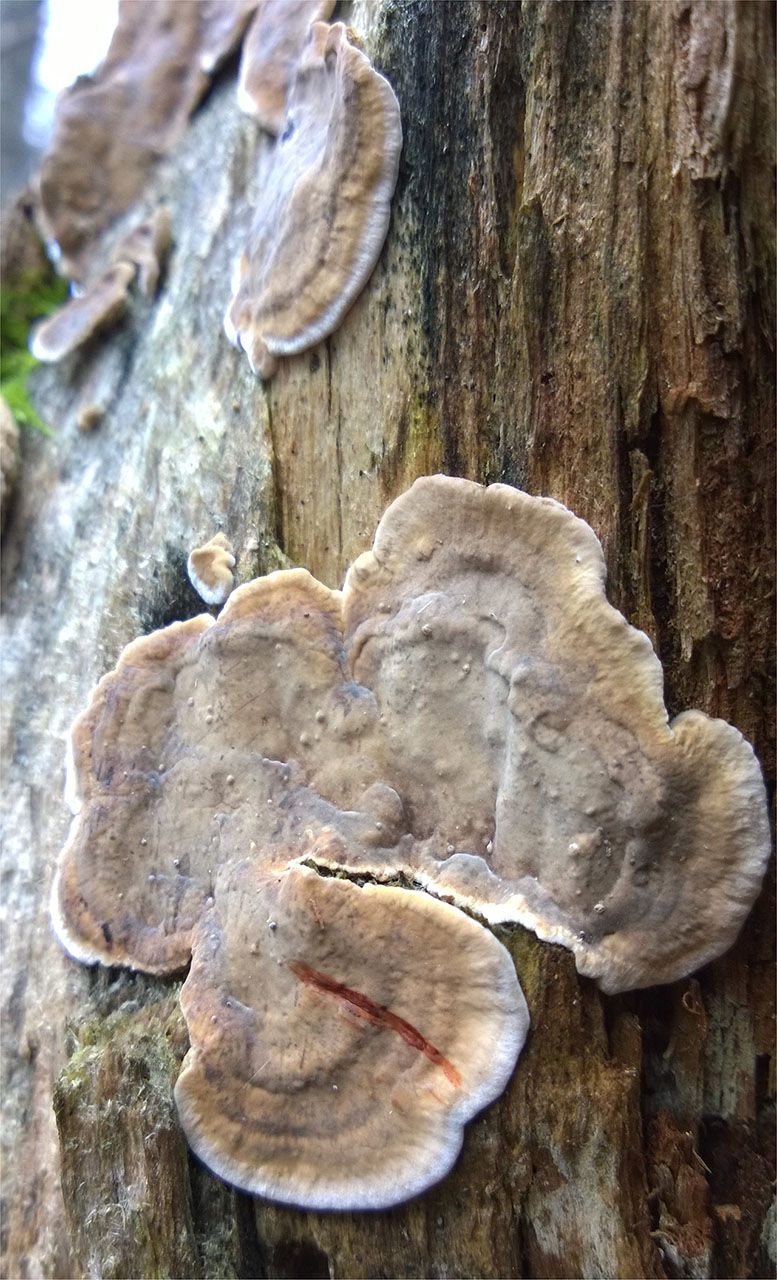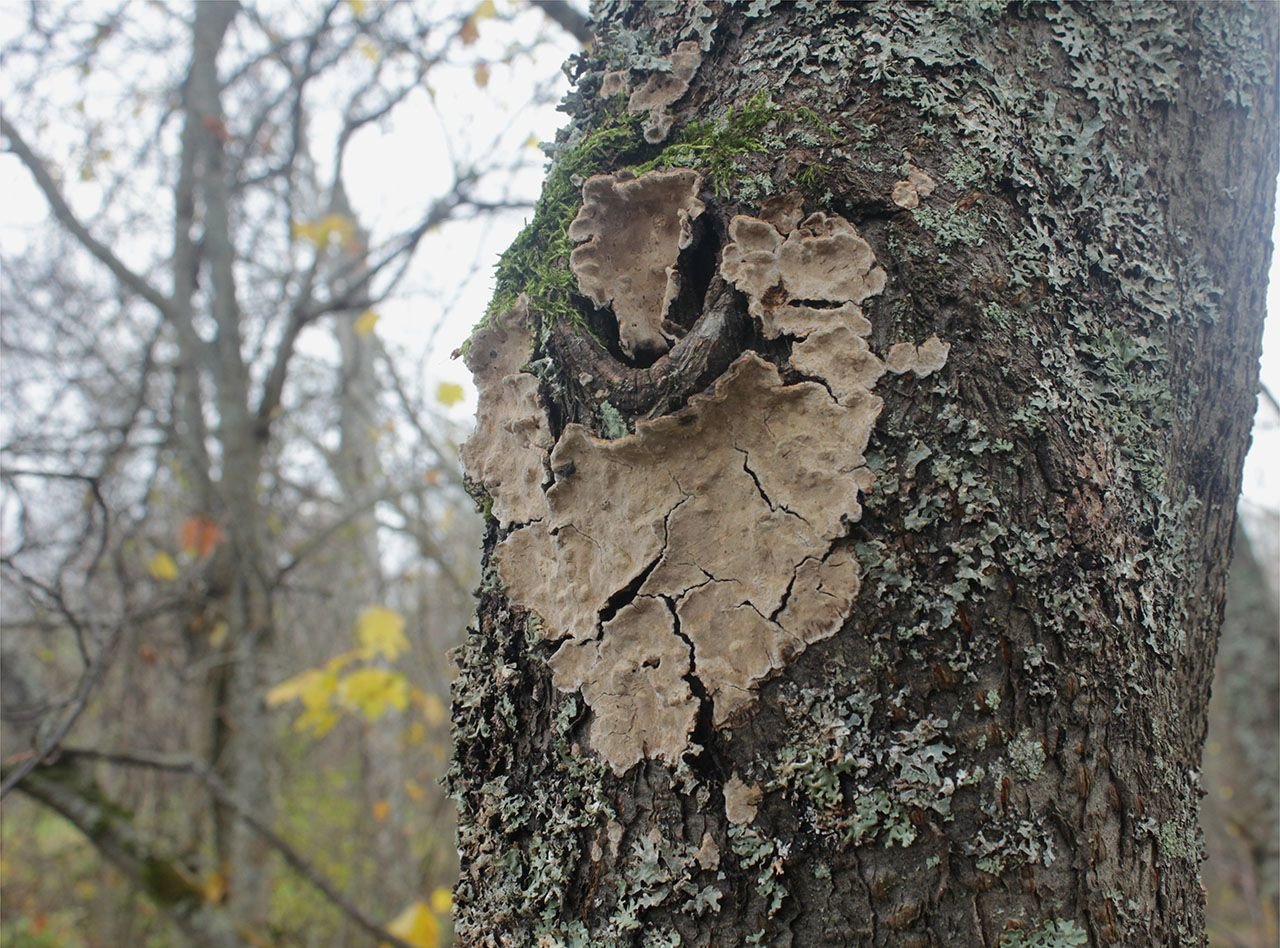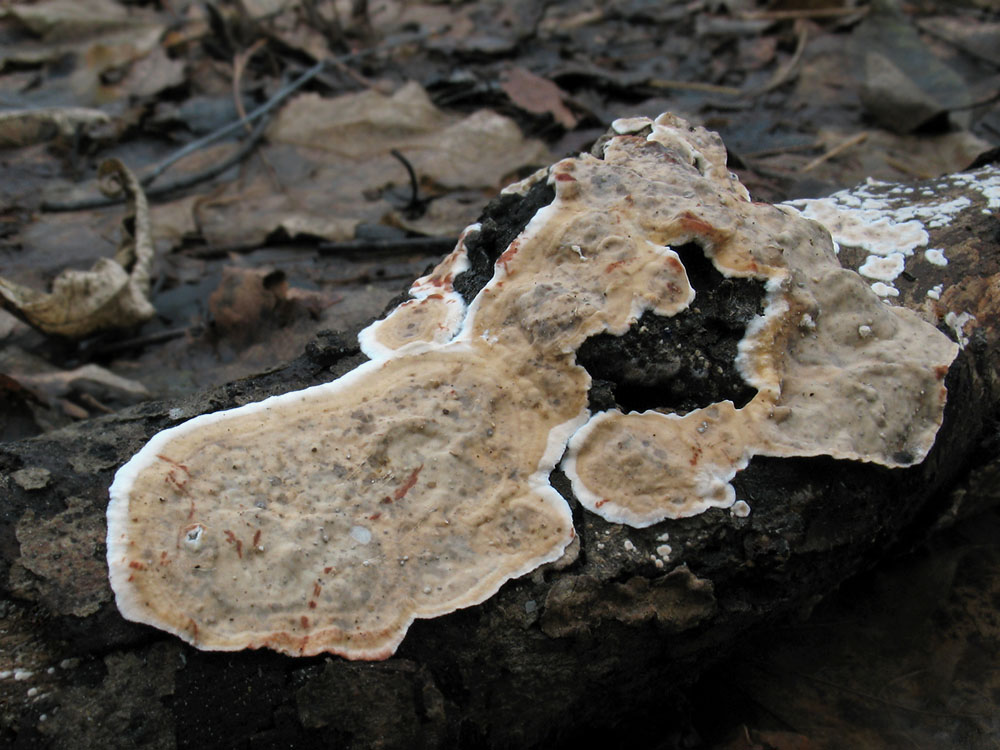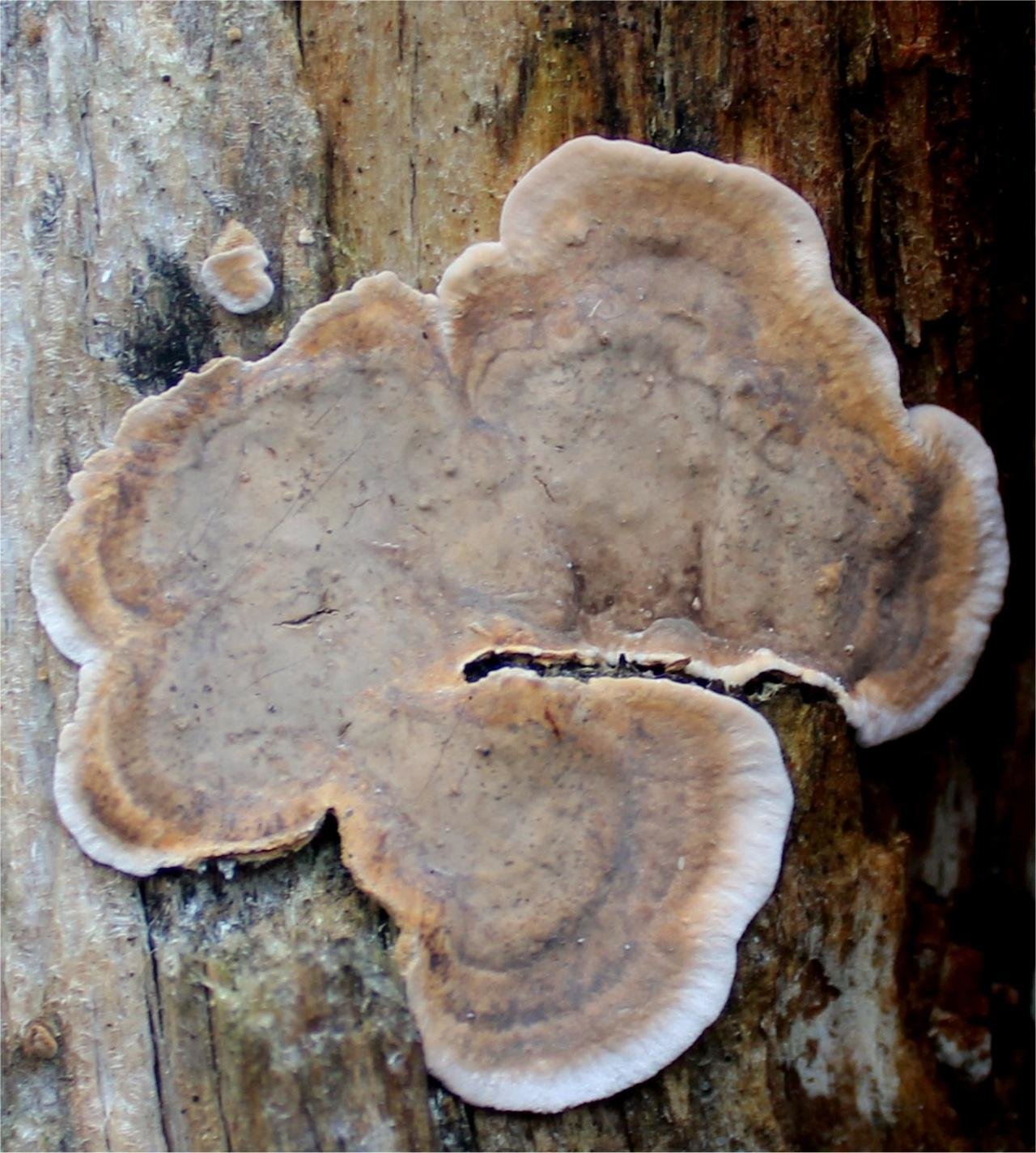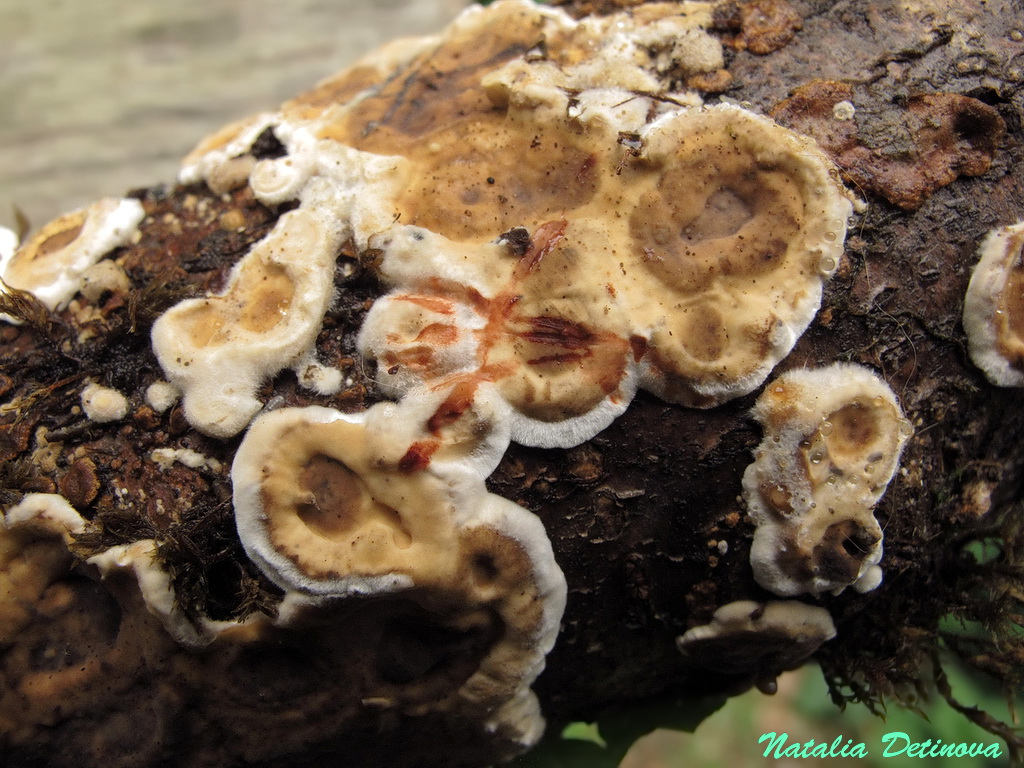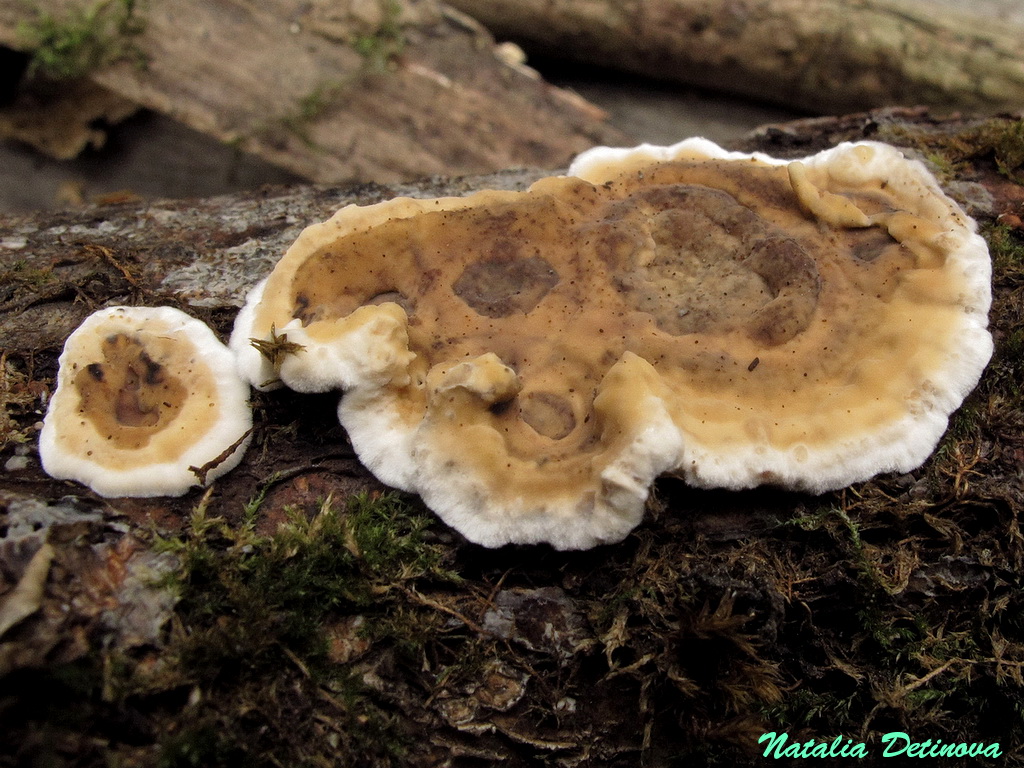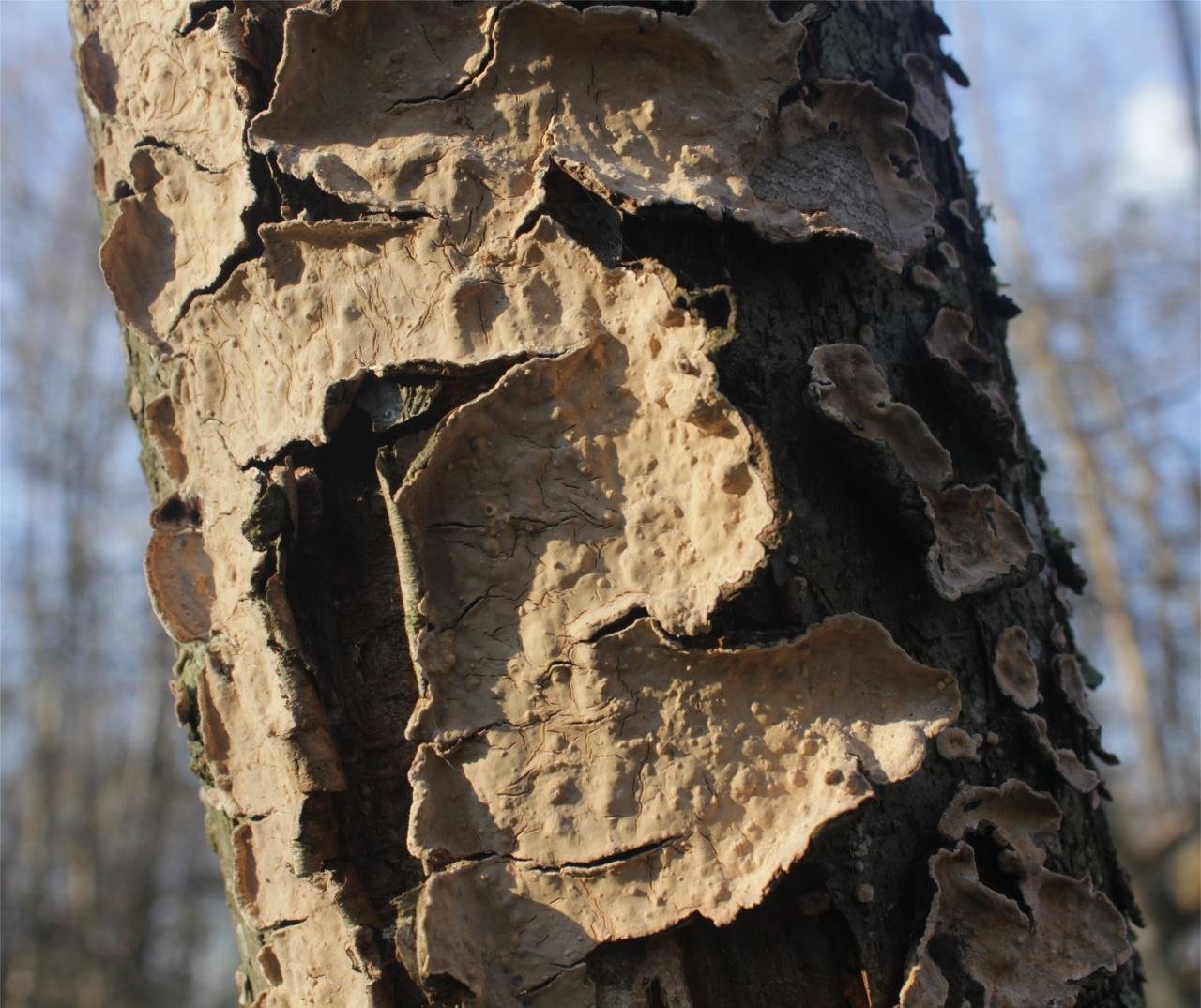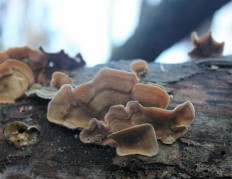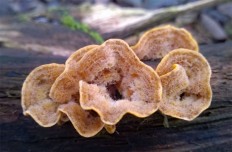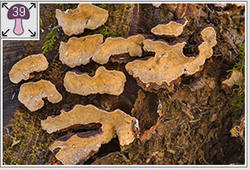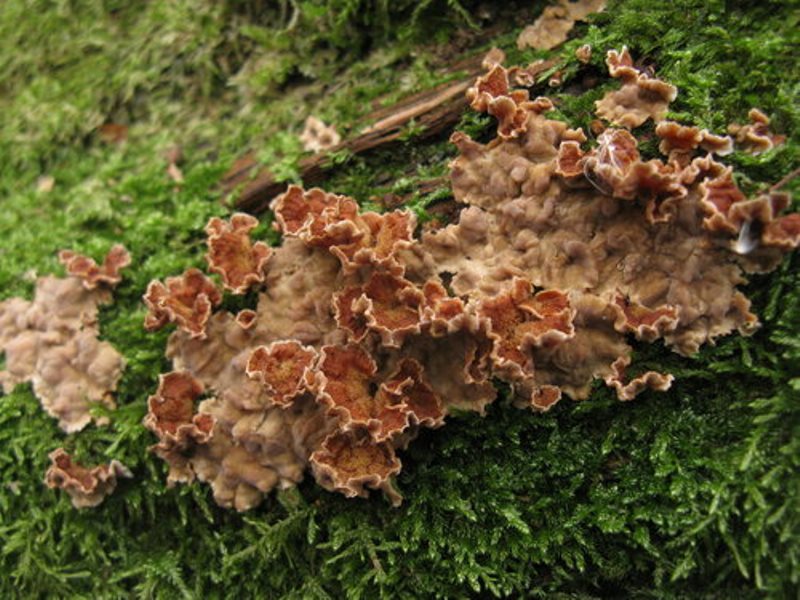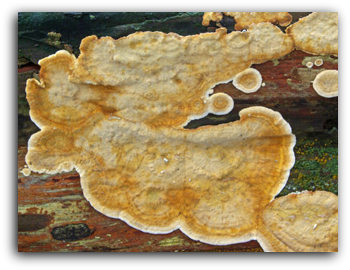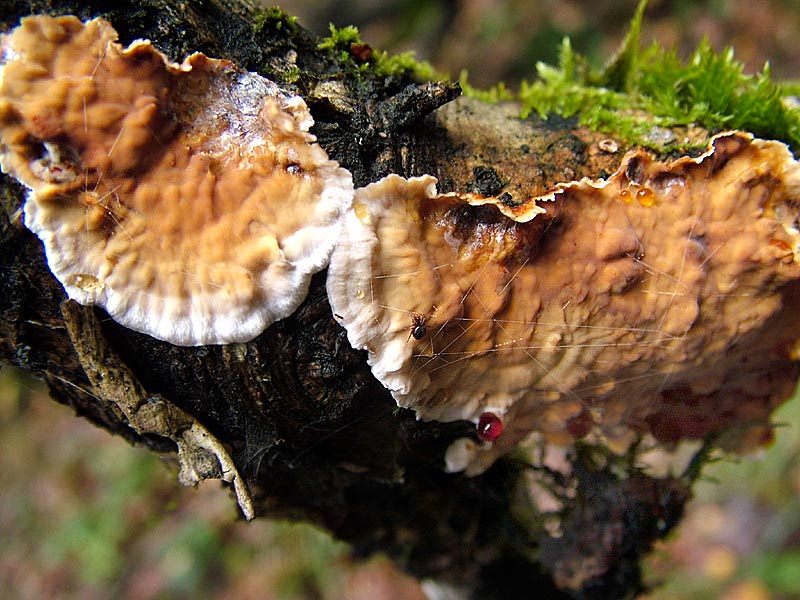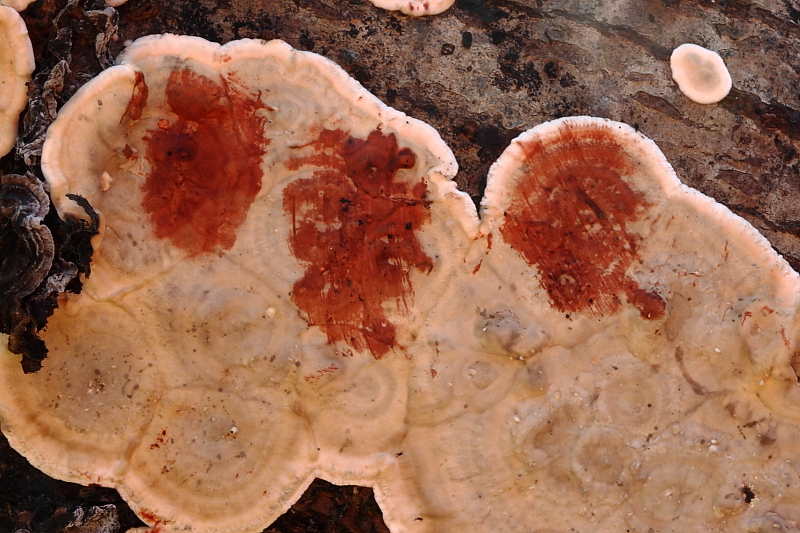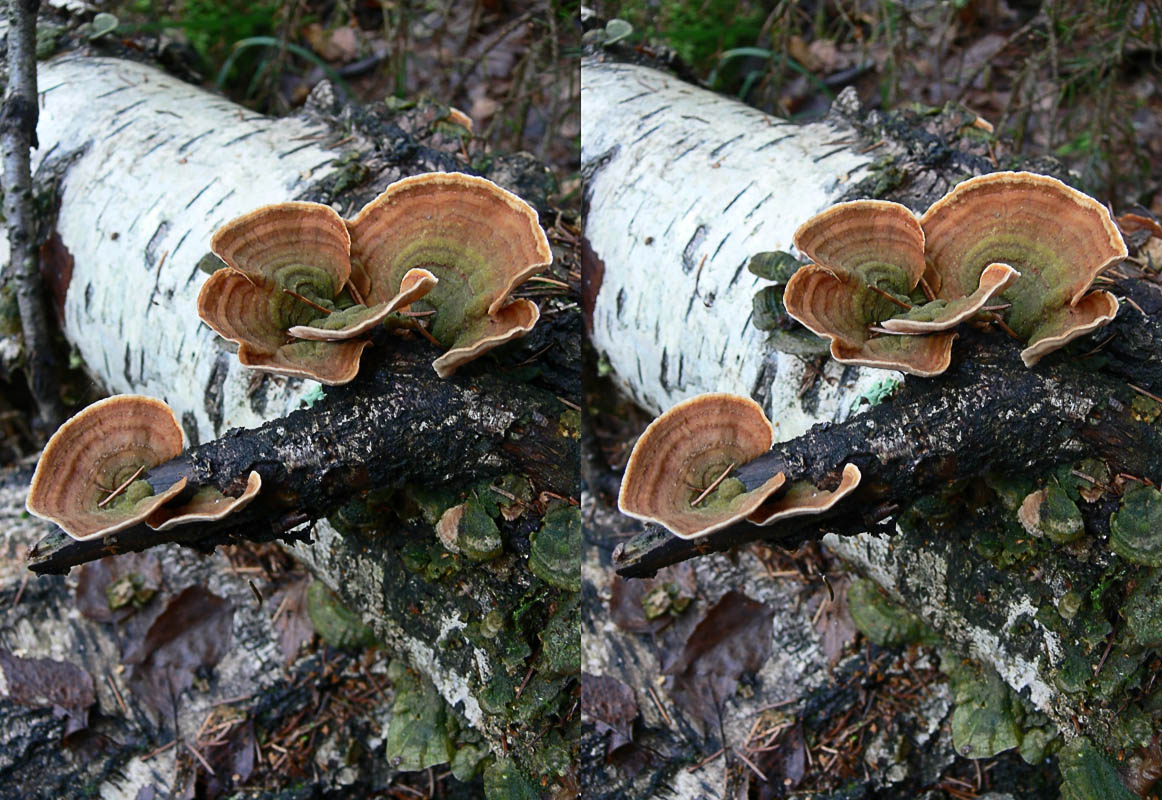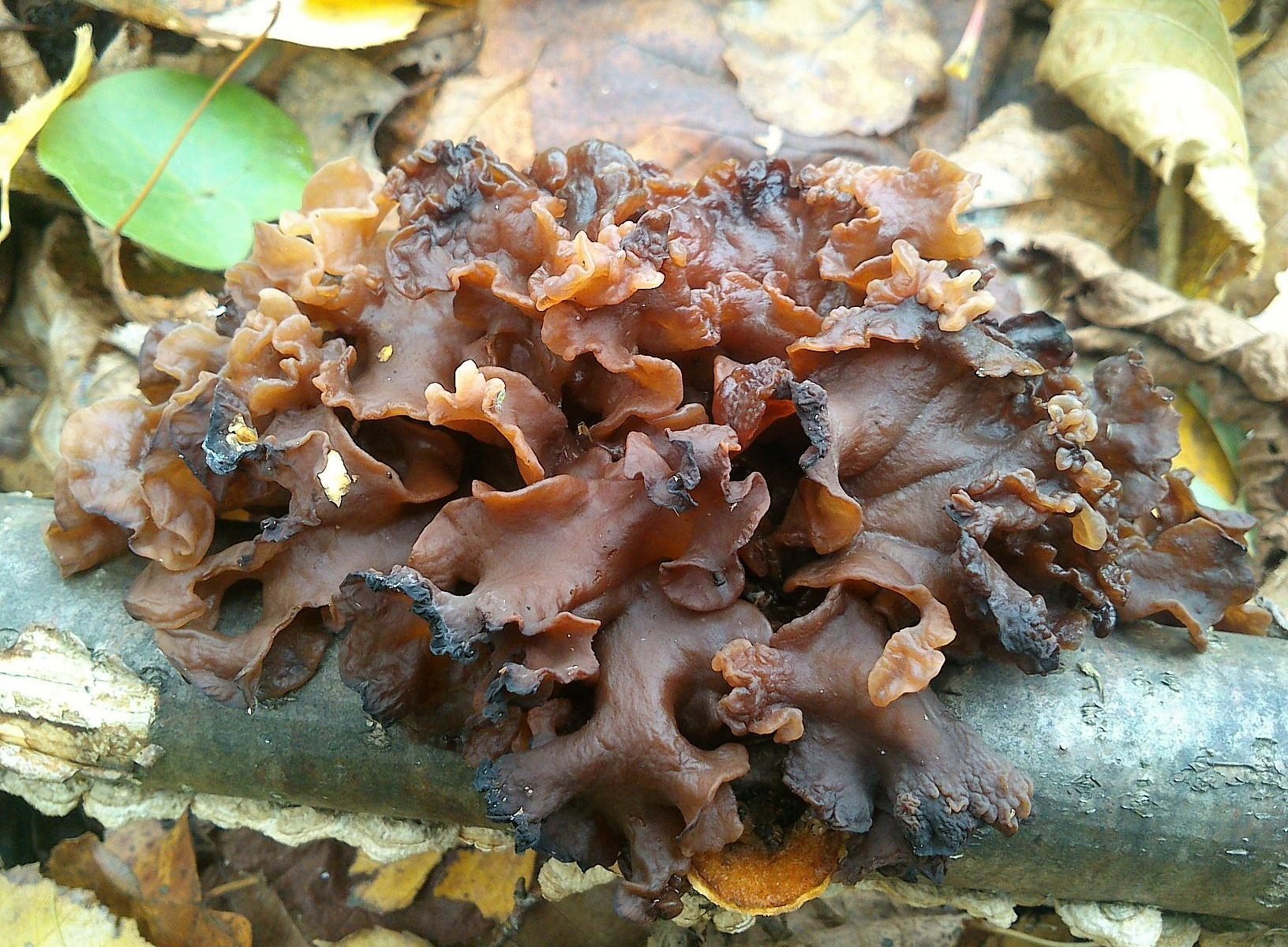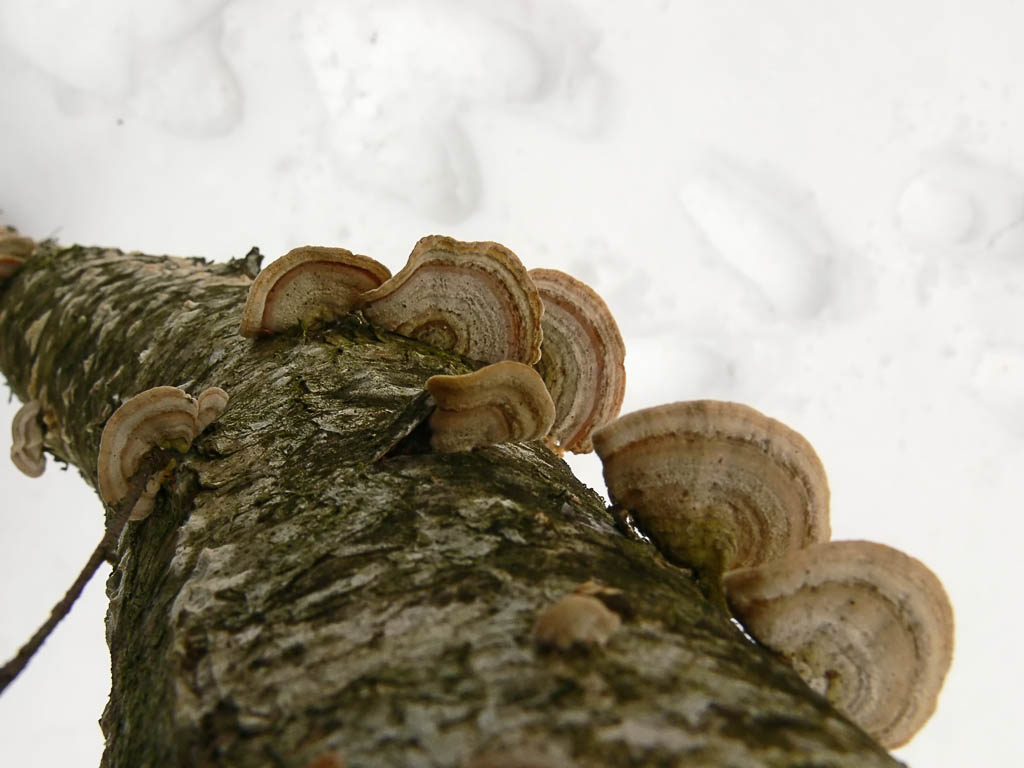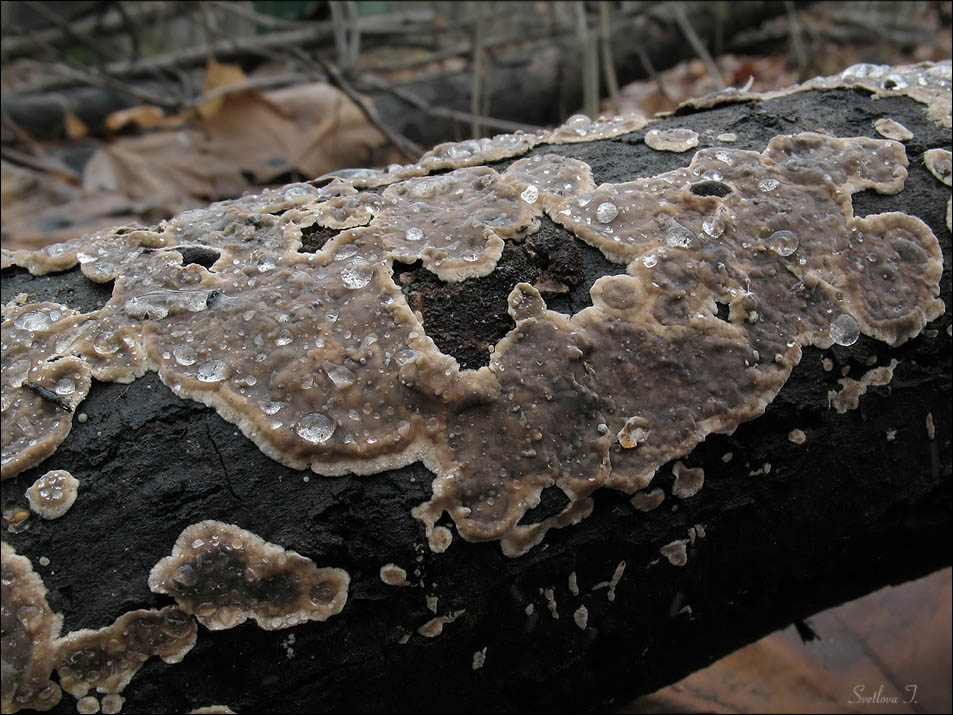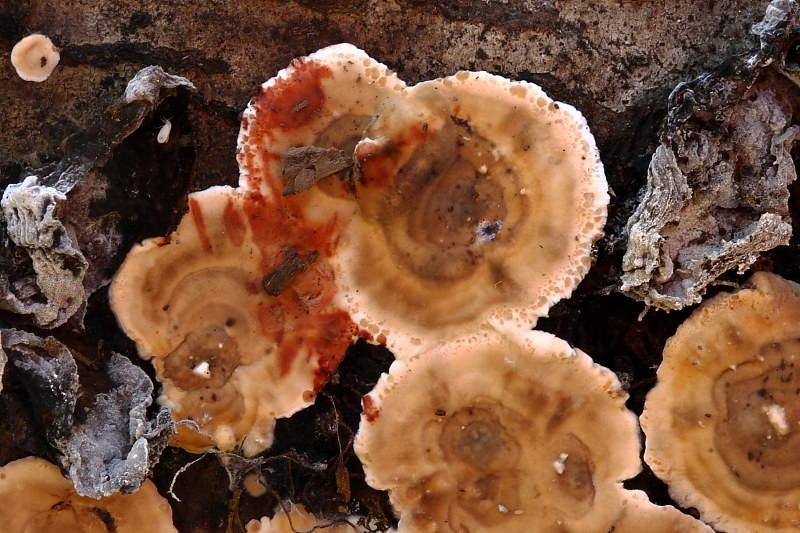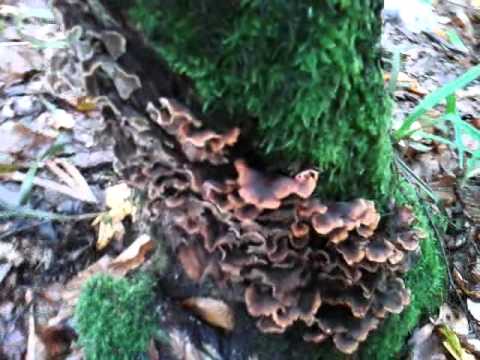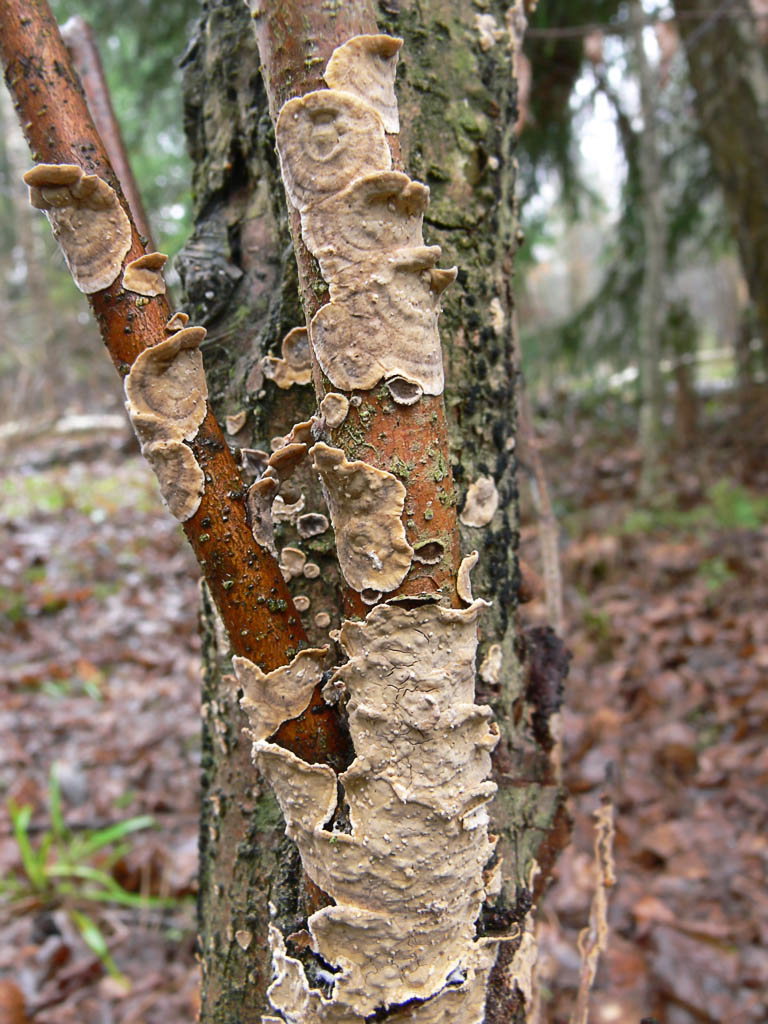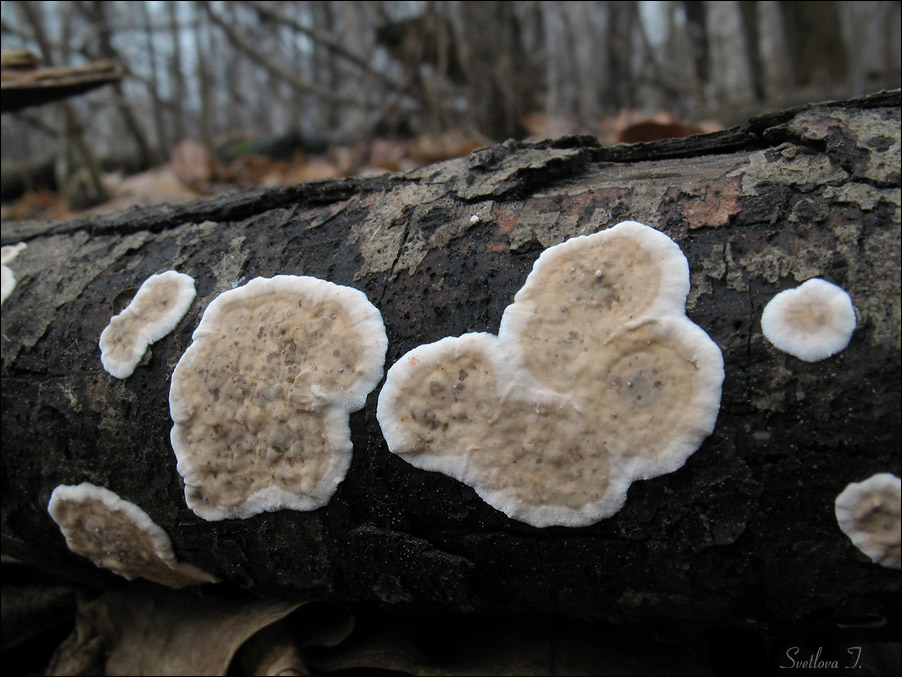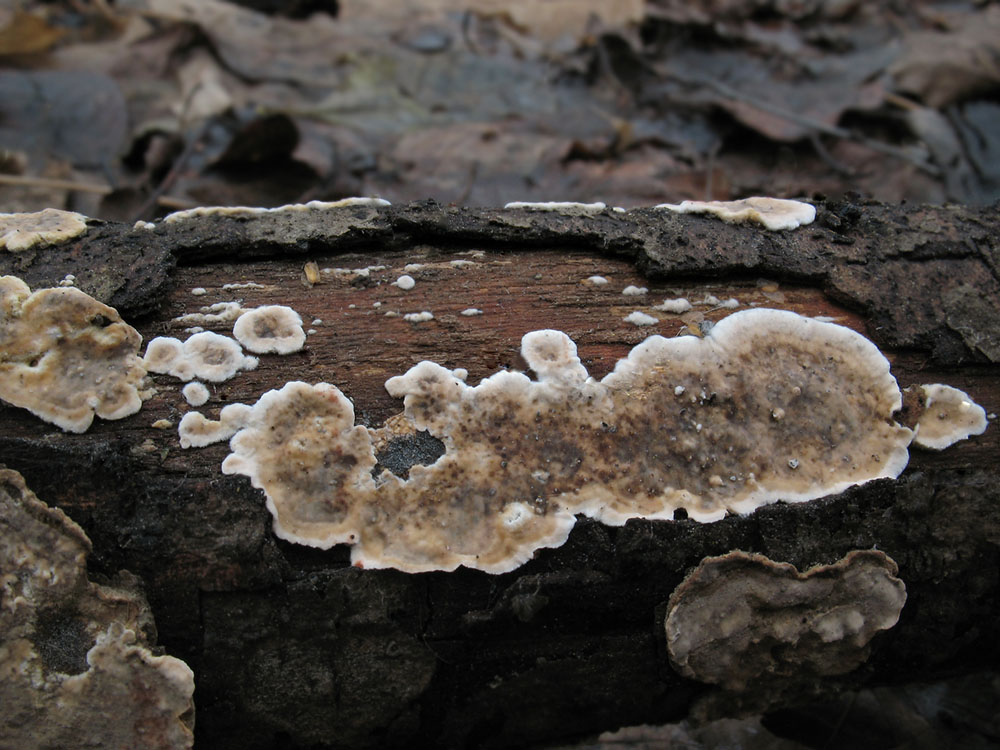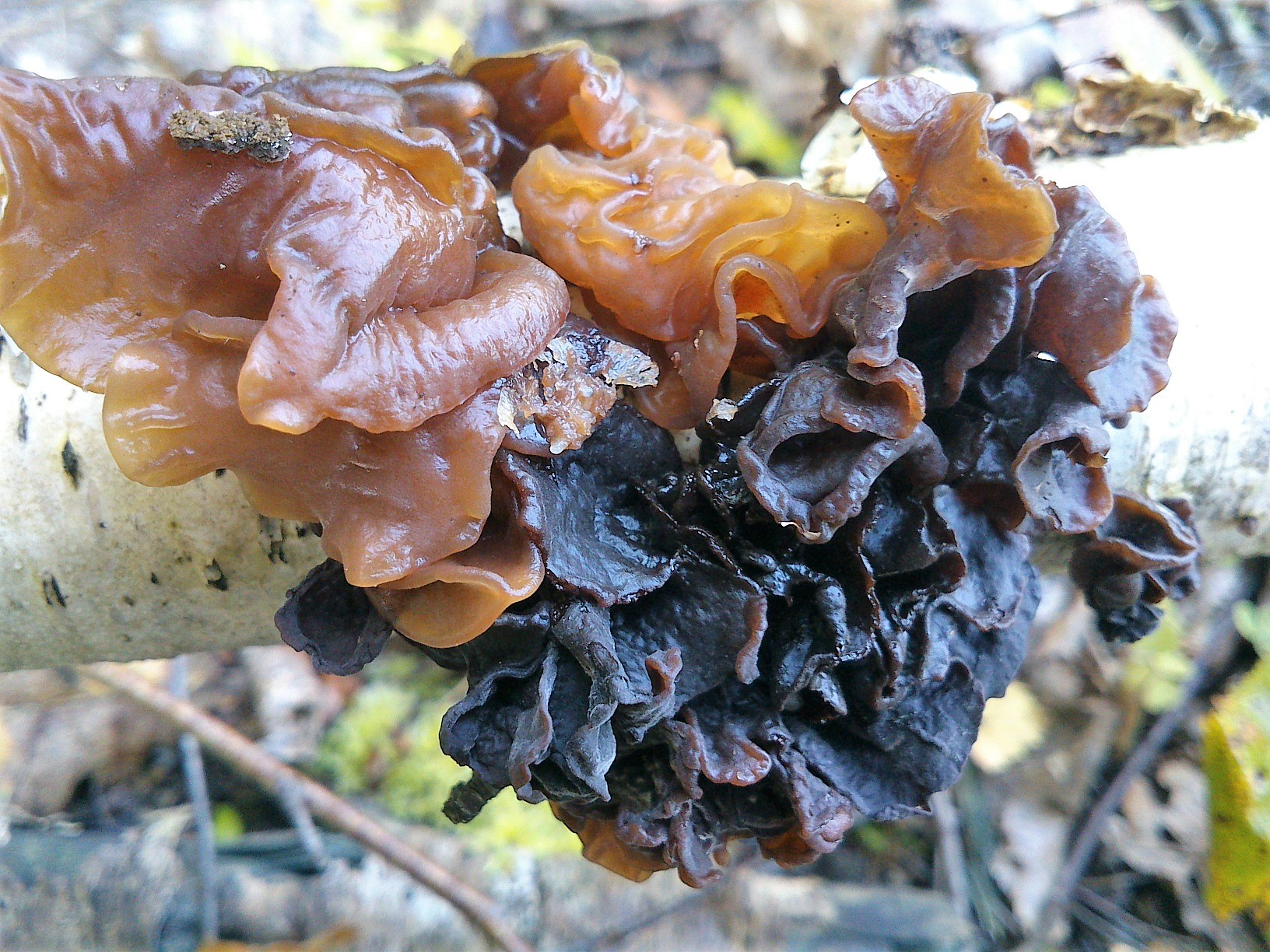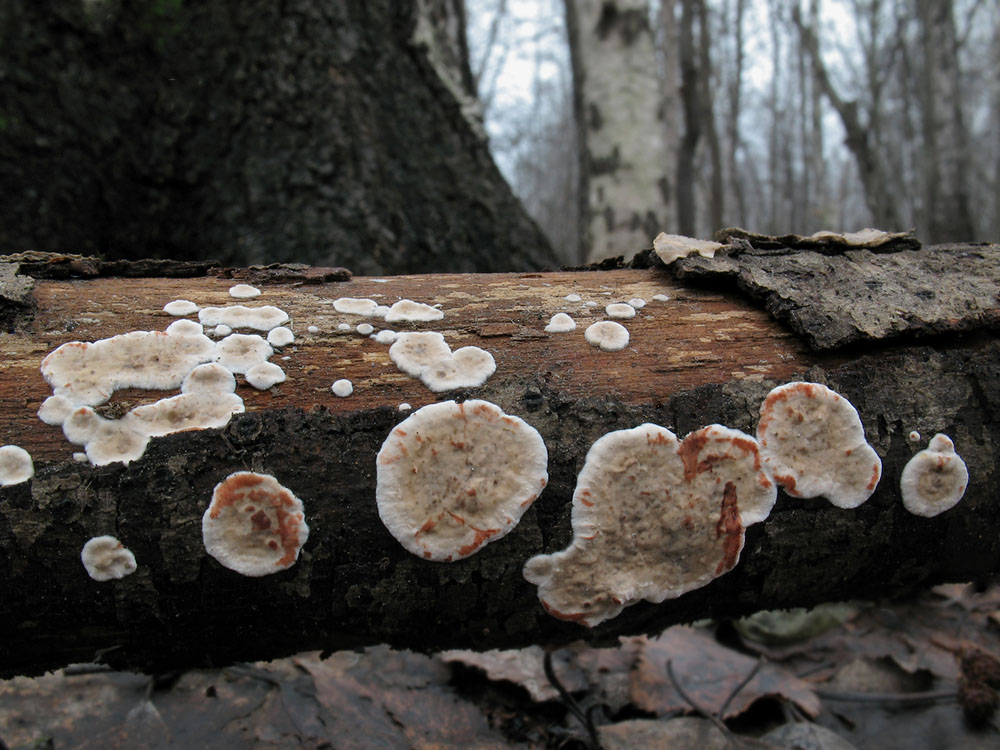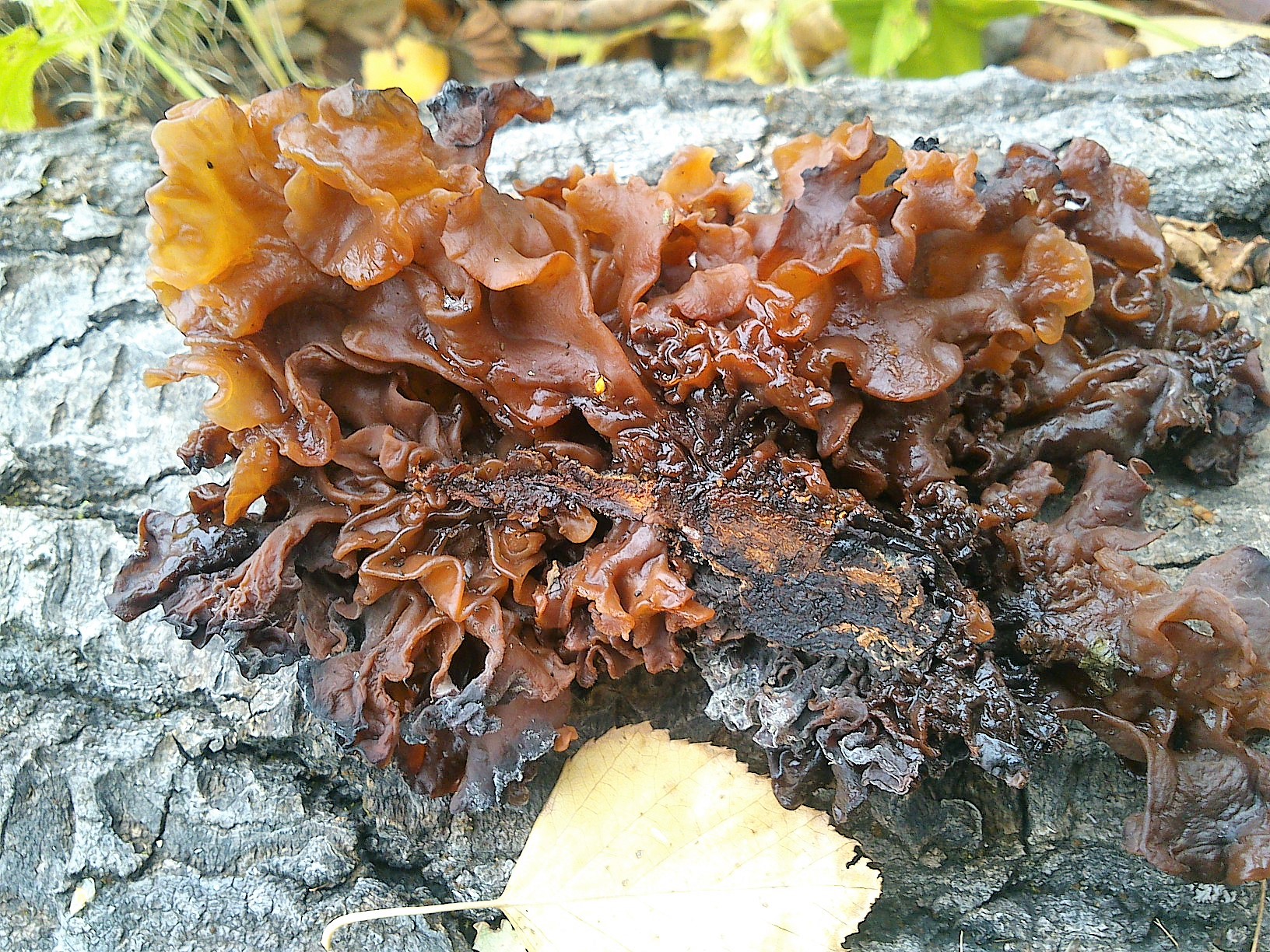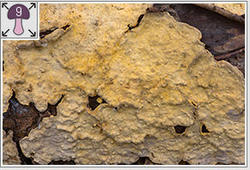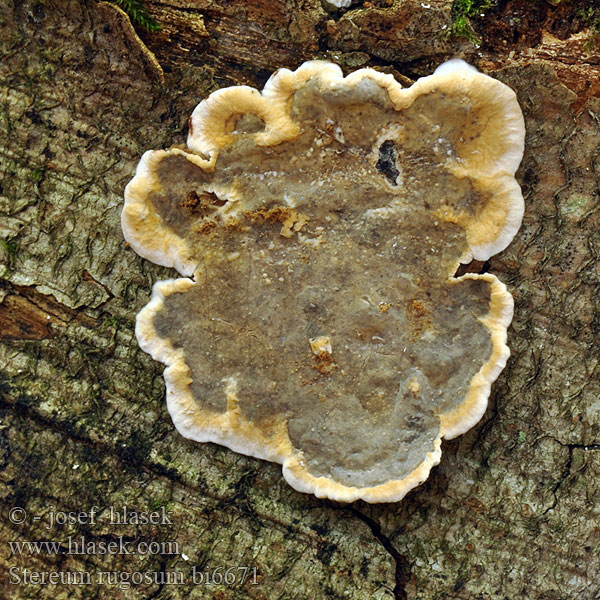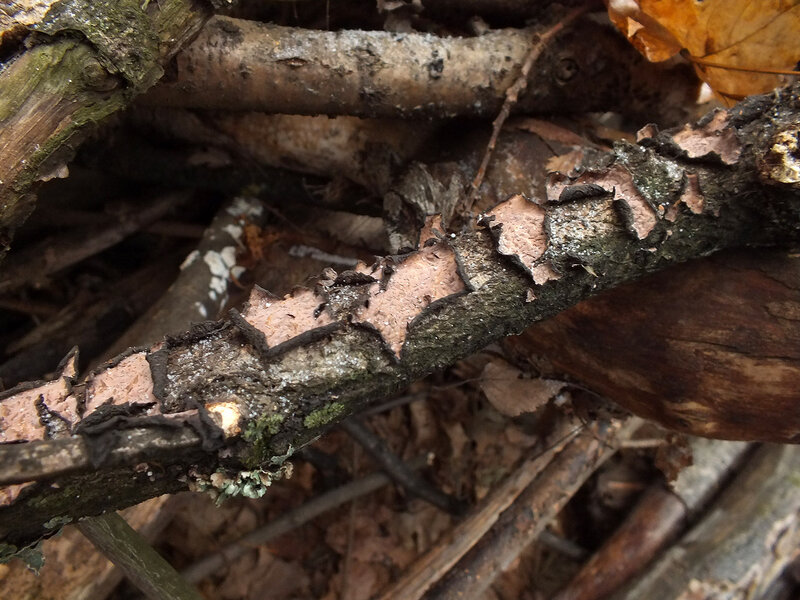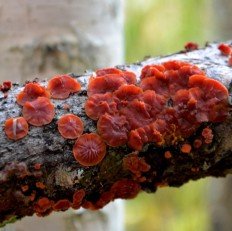Interesting Facts

It has been established that substances with anticarcinogenic and antimicrobial effects can be isolated from the fruit bodies of the coarse hairy stereum. However, their properties are under study.
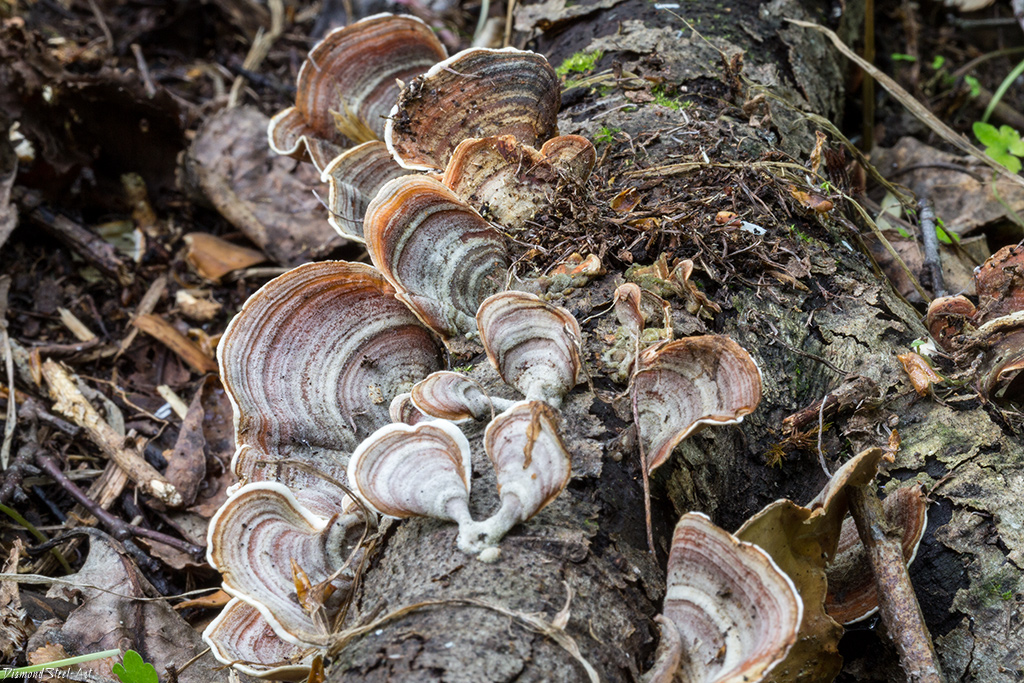
Current title
| Index Fungorum | Stereum subtomentosum Pouzar | |
| MycoBank | Stereum subtomentosum Pouzar |
Systematic position
Etymology of the species epithet
Subtomentosus, a, um, mic. a bit like felt. From sub- a little, a little, a little + tomentum, i, n, stuffing made of wool, straw, etc.
Synonyms
- Stereum ochroleucum subsp. arcticum Fr., Hymenomyc. eur. (Upsaliae): 639 (1874)
- Stereum arcticum (Fr.) Mussat, in Saccardo, Syll. fung. (Abellini) 15: 402 (1901)
Other names: Felt Stereum, Weakly felt Stereum.
Habit
Fruit body: Sedentary, cantilever, hoof-shaped, in the form of an irregular growth or rosette
Hymenophore: Smooth, not pronounced
Fruiting body
Fruiting bodies are annual, growing in a row or in tiled groups, outstretched-bent, fan-shaped, attached to the substrate by a wide base, sometimes funnel-shaped or coiled like a shell, and attached to the substrate by a tapering lateral false stem. Neighboring blades often grow together with each other and envelop the stalks of grass, twigs, and various forest debris encountered on the way. Individual fruiting bodies up to 50 (80) mm in width, 30 - 70 mm from edge to base and about 1 mm in thickness. The edge is always light, sometimes almost white, wavy or lobed. The surface is velvety, thin-lined, brightly and contrastingly colored: concentrically zoned with stripes of different shades of red, brown, gray and almost black. In old age and in dry weather, the surface fades and fades. In humid habitats, green and blue-green algae settle on the fruit bodies, coloring the surface in green shades.
The hymenophore is smooth, slightly lumpy, dull, sometimes with concentrically located grooves, gray-yellow, light brown, light ocher, turns yellow in the damaged areas.
Pulp
The pulp is fibrous, elastic, hard-leathery, yellow-ocher, ocher-brown. Smell and taste are mild.
Microscopy
Spores 5.5 - 6.5 × 2 - 3 μm, ellipsoid-cylindrical, smooth, hyaline.
Basidia 45 - 60 × 5 - 6 μm, narrow-clavate, 4-spore, without a buckle at the base.
There are no cystids; thick-walled terminal elements of skeletal hyphae ending in a rounded head 5 - 8 µm in diameter can be taken for them.
The hyphal system is dimitic, the generative hyphae are thin- and thick-walled, 2.5–4 µm in diameter; skeletal hyphae up to 8 µm in diameter, thick-walled.
Baffles without buckles.
Ecology and distribution
Substance: Woody plants (living trees, bark and dead wood)
Grows in groups on dead wood of many deciduous species. Causes white rot.
In Western Siberia, it lives mainly on birch, aspen, alder, willow. It is distributed from the northern taiga, where it occasionally occurs in burnt-out areas and in settlements, to the forest-steppe, where it becomes a background species.
Sterium is the cleanest database of quality ads that allows you to find housing, rent and sell properties quickly and safely. Show in full ...
Sterium refers to an ad as a quality ad that represents the object as fully as possible, contains detailed truthful information and is not the subject of spam, that is, multiple repetitions on the same site. On Sterium, real estate looks the same as in real life.
Only on Sterium, displaying any object takes no more than 5 minutes.
Thanks to the 3D tour in each ad, you can view the apartment without meeting the owner.
Thus, the time for viewing all the ads on the market that you are interested in is reduced significantly.
The result is a great deal. The seller and buyer, landlord and tenant do not waste time on meetings and shows and quickly find each other.
Types of mushroom porkhovka
Lead-gray flap (Bovista plumbea)
Also known as Devil's Tobacco and Lead Slicker.
The diameter of the fruit body is 1-3 cm, the shape is round, spherical, the root process is thin. The color is white or off-white in young mushrooms; as it matures, the fruit body becomes gray, steel, matte with a dense skin. After the mushroom ripens, a small hole with a ragged edge appears at the top of the mushroom, which is intended for the spread of spores. The pulp of the mushroom is white at first, later becomes grayish, odorless.
Gathering season flitting lead-gray lasts from June to September (mass fruiting occurs at the end of July and lasts until mid-September). The fungus grows on sandy soil, in woodlands, on roadsides, forest glades and meadows, singly or in small groups.
Edible mushroom, young specimens with a light fruiting body and white pulp are used for food.
Blackening flap (Bovista nigrescens)
The fruit body is spherical or flattened, without a stem, 3-6 cm in diameter. Young mushrooms are white, gradually acquiring a yellowish tint. After the spores mature and the outer shell breaks open to discard them, the fungus turns almost black. The flesh of young specimens is white, darkens as the fungus grows.
The beginning of growth of this species is observed from the beginning of June and lasts until the second half of September. The mushroom grows in forests of different typesas well as in meadows, along roads, on rich soils.
Young mushrooms are edible, of low quality.
Sorrel
Sorrel is one of the most famous edible plants. It is often grown independently in vegetable gardens, but can also be found in the wild. It is localized mainly in fields, meadows, along rivers and lakes.
The sour taste familiar to many is justified by the high content of organic acids. In the composition you can also find vitamins A, B, C and tannins. The stem of the plant is straight, and the leaves are spear-shaped.
Sorrel does not require any pre-treatment, except for washing, the leaves can be eaten immediately or added to other herbs and vegetables, making a healthy salad. And, of course, it is an indispensable component for sour cabbage soup.
Characteristics [edit]
Stereum species are wood decay fungi. Their simple, shelving fruiting bodies have a smooth hymenium, lacking gills or tubes. Like most members or the family Stereaceae, Stereum fruiting bodies lacking clamp connections and produce amyloidbasidiospores.
The species can be divided into two groups: the bleeders (those that exude a red liquid from cut surfaces, similarly to Lactarius species) and the non-bleeders (those that do not). In 1959, Zdenek Pouzar created a distinct genus, Haematostereum, for the bleeding species of Stereum, including H. gausapatum, H. rugosum, and H. sanguinolentum... Modern authors do not consider Haematostereum to be a distinct genus, so it is currently treated as a synonym of Stereum.
How does a wrinkled stereo look
The variety has a flattened, tough fruiting body. With massive growth, they grow together, organizing long wavy ribbons. You can find them out by the varietal description.
They can have a different appearance:
- The rounded edges are thickened into a small ridge.
- The flat fruit body has a rough surface and wavy, folded edges. The width of the folded edge is not more than 3-5 mm. The hard surface is covered with a dark brown paint with a pronounced lightened stripe along the edge.
- Less common is a mushroom located on a tree in the form of caps with a common common base.
The bottom part is even, sometimes with small bulges, covered with cream or light yellow paint, turns into pink-brown with age. In dry weather, the fruit body hardens and cracks. In case of mechanical damage, red milky juice is released. This reaction occurs even in dried specimens if the fracture site is soaked in water in advance.
The pulp is tough or corky, gray in color, has no smell or taste. On the cut of old specimens, thin annual layers are clearly visible.
Reproduction occurs with transparent long spores, which are located in a light yellow spore powder. It bears fruit during the entire warm period.
To dream
Perennial plant of the umbrella family. On long, thin stems, there are a large number of oblong leaves. Depending on the location, this edible forest plant may have an umbrella of small white flowers on top. They appear in conditions of abundant sunlight. Prefers the territory of wastelands, deciduous forests, forest edges.
It is best to eat young shoots, leaves and petioles. They can be identified by their very light, almost transparent yellowish-green color. Before you start eating the plant, it must be boiled for at least 1-2 minutes.In this case, the skin must be removed from the stem. The cooked leaves are delicious with butter. It is very often added to soups.
Recommendations
| Wikimedia Commons has media related to Stereum . |
LAT Chondrostereum purpureum Inedible Synonyms: Stereum purpureum, Stereum ardoisiacum, Stereum argentinum, Stereum atrozonatum, Stereum lilacinum, Stereum lilacinum var. vorticosum, Stereum micheneri, Stereum nipponicum, Stereum pergameneum, Stereum rugosiusculum, Stereum vorticosum, Corticium nyssae, Terana nyssae, Thelephora purpurea, Thelephora vorticosa, Auricularia persistener purple, purple purple
Specifications:
| Group: | Smooth |
|---|---|
| Plates: | Absent |
| Colour: | Gray with a beige tint, yellowish brown, light gray, lilac white |
Systematics:
| Department: | Basidiomycota (Basidiomycetes) |
|---|---|
| Subdivision: | Agaricomycotina (Agaricomycetes) |
| Class: | Agaricomycetes (Agaricomycetes) |
| Subclass: | Agaricomycetidae |
| Order: | Agaricales (Agaric or Lamellar) |
| Family: | Cyphellaceae (Cyphellaceae) |
| Genus: | Chondrostereum (Chondrostereum) |
| View: | Chondrostereum purpureum (Stereum purple) |
This mushroom is from the category of those from which there is no benefit, except harm. Cherry and plum gardeners are very familiar with him. This mushroom is able to kill a young fruit tree in just 2 years. At the beginning, a silvery coating appears on the wood, and then the tree simply dies, affected by white rot. Owners of warehouses of building materials and various wooden buildings also encounter him. Like the white house mushroom, it infects wood in poorly ventilated areas.
External description
Wrinkled psatirella is a fruiting body consisting of a cap and a stem. In it, the leg is located in the center, has medium or small sizes.
The cap initially has a spherical shape, very thin, it can be cone-shaped or bell-shaped. As the mushroom matures, it opens completely and becomes flat, while the color of the fruit body varies from whitish to brownish. The flesh of the mushroom is not too fleshy, thin, brittle and fragile.
The leg of psatirella wrinkled, fibrous, fragile, long and very thin. Its color is comparable to the shade of the cap, sometimes a little lighter than it. The surface of the leg is scaly or felt to the touch.
The residual parts of the bedspread remain especially noticeable at the edges of the cap, taking on a film or cobweb shape. A ring on a leg is rare, mainly mushrooms from the psatirella family have neither a vulva nor a ring.
The fungal hymenophore is represented by a lamellar type, and the plates are located under the cap either freely, or slightly fused with the surface. Initially, the plates are white, but as the wrinkled psatirella matures, they begin to darken, acquiring a purple-brown, black or brown hue. Often, the plates of a mature fungus have a characteristic difference - light edges.
In psatirella wrinkled, the spores are smooth to the touch, have a time of germination, and are either black or dark purple in color. The spores contain special components - cheilocystids, which can have various shapes - clavate, bag-shaped, bottle-shaped, sometimes with a beak-shaped outgrowth. The spore powder is purple, dark brown or almost black in color.
Cooking recipes
From this type, you can cook many delicious, unusual dishes and diversify your diet.
Cleaning
How to clean lobsters properly:
- Rinse them under running water.
- Pry the skin with a knife and remove it.
- Remove traces of decay.
- Rinse well again, dry.
Cooking
Boil the peeled mushrooms in salted water for 20-25 minutes. It is always recommended to do this before any culinary treatment.
- 2 kg of mushrooms;
- 1 liter of water;
- 60 ml vinegar;
- 2 tbsp. l. salt;
- 1.5 tbsp. l. Sahara;
- 1 tsp black peppercorns;
- 2-3 pcs. carnations.
Step by step cooking
- Sterilize the jars.
- Boil the mushrooms over medium heat until they settle to the bottom.
- Pour the broth into another saucepan using a colander.
- Rinse the lobsters with cold or cool water.
- Add the broth with salt, sugar, pepper and cloves, boil.
- Add mushrooms to the marinade and cook for 7 minutes.
- Cook with vinegar for another 5 minutes.
- Fill the jars with mushrooms boiled in the marinade.
- Cover with boiling brine.
- Roll up the cans with metal lids.
Freezing
Large, dry and crumbling, rotten specimens are categorically not subject to this procedure. It is better to freeze fewer mushrooms, but better quality and stronger in shape.
- Clean the mushrooms from grass and dirt, wipe with a napkin.
- Spread out on a tray and place in the freezer for 15 hours.
- Distribute into containers and packages.
- Send it back to the freezer.
Frying
In this recipe, you cannot use fresh garlic, which will only spoil the taste of the dish. Choose a canned vegetable or a spice.
- 0.5 kg of lobsters;
- 100 g lard with meat layer, cut into small pieces;
- canned garlic;
- salt and freshly ground black pepper to taste;
- 1 tbsp. l. chopped parsley;
- 1 tbsp. l. oregano spices.
Step by step cooking
- Wash, dry and chop the mushrooms.
- Place the bacon over medium heat and cook for 5 minutes. Add mushrooms and garlic and cook for 8 minutes until the liquid evaporates.
- Sprinkle with salt and pepper at the end of cooking.
- Add parsley and oregano to the finished dish.
Salting
Too large "lobsters" are not suitable for pickling. Give preference to undamaged medium to small mushrooms. They are salted much faster.
While searching for mushrooms, experienced lovers of quiet hunting immediately notice and remove all kinds of forest debris in the form of adhered blades of grass and leaves. It is almost impossible to remove sand by hand, but it is easy to do with a toothbrush. Then they are dipped in a container with plenty of water.
It is advisable for lobsters to "take" a sour-salt bath for the next day. The proportions are calculated as follows: for one liter of water, take 2 g of citric acid and 10 g of rock salt. Finally, you need to thoroughly rinse the contents of the container.
It is recommended to fill in enamel buckets, glass jars and barrels. Clay and zinc dishes will not work, as the salt will remain on the walls.
Per kilogram of mushrooms you will need: 125 ml of water, 2 tablespoons of salt (regular, without iodine), bay leaf, a head of garlic, dill umbrellas, vegetable oil (depending on the size of the container).
Step by step cooking
- Cut off the caps and pour boiling water over them.
- Peel the garlic, finely chop the cloves.
- Place 2 dill umbrellas on the bottom of the container, put half of the lobsters.
- Sprinkle 2 tablespoons of rock salt on top, half of the whole serving of garlic.
- Place these ingredients in the same order except for the rock salt and finish with 2 dill umbrellas.
- Cover with a disc slightly smaller than the diameter of the container.
- Press down with something heavy (a container with water or a special circle), leave for a day. After 24 hours, remove the disc, fill the contents with oil so that it completely covers the contents of the container.
Species [edit]
S. hirsutum and S. ostrea are members of a species complex, some members of which can cannot be reliably distinguished without microscopic analysis.
There are numerous species in this genus (and family), the commonest one being by far Stereum hirsutum.
- Stereum acanthophysatum
- Stereum adnatum
- Stereum albostipitatum
- Stereum alternum
- Stereum antarcticum
- Stereum aotearoa
- Stereum aratum
- Stereum armeniacum
- Stereum auriscalpium
- Stereum aurora
- Stereum avellanaceum
- Stereum azonum
- Stereum bagliettoanum
- Stereum beigehymenium
- Stereum bellum
- Stereum bombycinum
- Stereum boninense
- Stereum braunii
- Stereum burtiasmum
- Stereum burtissimum
- Stereum campaniforme
- Stereum carthusianum
- Stereum complicatum
- Stereum cupulatum
- Stereum durum
- Stereum earlei
- Stereum elongatum
- Stereum fasciatum
- Stereum gausapatum
- Stereum hirsutum
- Stereum insignitum - may be considered a synonym of Stereum subtomentosum
- Stereum ostrea - False turkey tail. Sometimes considered a variety of *Stereum hirsutum.
- Stereum papyrinum - Preferred name: Lopharia papyrina
- Stereum purpureum - Silver leaf fungus. Preferred name: Chondrostereum purpureum
- Stereum rugosum
- Stereum sanguinolentum
- Stereum subtomentosum
- Stereum taxodii - Preferred name: Laurilia taxodii
Horse sorrel (wild sorrel)
Wild sorrel is an edible plant familiar to many. It is very similar to its small brother, the common sorrel. The difference lies in the size and structure of the leaves, which are much larger and stiffer in the equine species. The total plant height can reach two meters in height.
Due to the fact that the leaves are quite dense, they do not taste as good as in the usual species, but they are quite edible. All parts of the plant are rich in tannins, essential oils, vitamins and trace elements. And if the root is better used for making decoctions, then the leaves and petioles can be eaten fresh, for example, as part of a vegetable salad.
It is often found in forest and forest-steppe zones, in meadows, and horse sorrel loves wet swampy areas.
What is Lobster mushroom?
Hypomyces lactic acid is a mold that grows on the fruiting bodies of other species.The Latin name is Hypomyces lactifluorum. In common people it is called a lobster mushroom.
| Mushroom type: | edible |
| Other names (synonyms): | Lobster mushroom |
| Latin name: | Hypomyces lactifluorum |
| Family: | Hypocreaceae |
| Distinctive feature: | contrary to its common name, not a mushroom, but rather a parasitic ascomycete that grows on certain types of mushrooms, covering them in a reddish orange color that resembles the outer shell of a boiled lobster. |
| Season start: | September |
| End of the season: | November |
| Smell: | shellfish |
| Taste: | soft |
| Tasting score: |
Have you tried this mushroom? Then rate it!
Fruit body:
tough, has the appearance of an orange mold; quickly attacks the owner and soon completely absorbs it; the surface is dotted with tiny pimples.
Leg:
–
Hymenophore (lower part of the cap):
–
Disputes:
fusiform, 35-50 x 4-5 microns.
Pulp:
–
Natural environment and mycorrhiza:
grows on the fruiting bodies of other mushrooms.
False doubles:
–
Cultivation:
–
Use:
quite suitable.
Medicinal properties:
–
Spreading:
North America.
Description
The harsh stereum is a small, woody, inedible fungus that grows on dead wood or weakened trees and causes white rot.
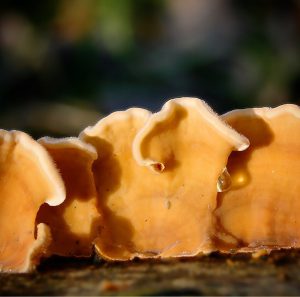 Fruiting body
Fruiting body
It resembles a fan in shape. It grows to the substrate with its entire edge. The size is rather small - up to 3 cm in diameter. Usually these mushrooms are located in large clusters in the form of tiles. The upper surface is covered with hard hairs, has a yellow-brown (sometimes with a greenish tint due to algae on the surface of the fungus) color. The lower (spore-bearing) surface is not pubescent, yellowish or brownish, becomes grayish in the cold, darkens with mechanical damage.
Ring stropharia (Stropharia rugoso-annulata)
- Other names for the mushroom:
- Stropharia ferry
- Koltsevik
Synonyms:
- Stropharia ferrii
 Hat:
Hat:
at a young age, the surface of the cap of this rather common and today cultivated fungus changes color from yellowish to reddish-brown. In mature mushrooms, the cap becomes pale yellow to chestnut. In diameter, the cap can reach up to 20 cm. The mushroom weighs about one kilogram. In young mushrooms, the cap has a hemispherical shape, resembling porcini mushrooms. But, the bent edge of their cap is connected to the leg with a thin skin, which bursts when the cap ripens and the mushroom grows. In young ringers, the lamers are gray. With age, they become darker, lilac, just like the spores of the fungus.
Leg:
the surface of the leg can be white or yellowish brown. There is a ring on the leg. The pulp in the leg is very firm. The leg length can be up to 15 cm.
Pulp:
under the skin of the cap, the flesh is slightly yellowish. It has a rare smell and a mild, pleasant taste.
Edibility:
The ringlet is an edible valuable mushroom that tastes like a porcini mushroom, although it has a specific smell. The pulp of the mushroom contains many B vitamins and many minerals. It contains more niacin than cucumbers, cabbage and tomatoes. This acid has a beneficial effect on the digestive organs and the nervous system.
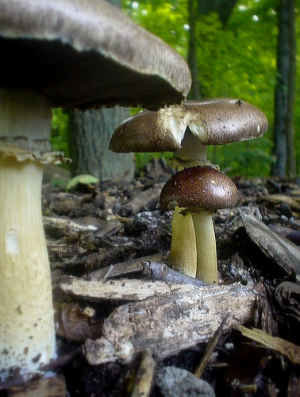 Similarity:
Similarity:
Ringworms are the same lamellar as russules, but in color and shape they are more reminiscent of noble boletus. The Koltsevik tastes like a boletus.
Spreading:
For this type of mushroom, it is enough to simply prepare a nutritious substrate. Compared to champignons, they are not whimsical to growing conditions in personal plots. Ringworm mainly grows on well fertilized soil, on plant remains outside the forest, less often in deciduous forests. The fruiting period is from early summer to mid-autumn. For home cultivation, they choose sheltered from the wind, warm places. It can also be grown under film, in greenhouses, basements and in beds.
Notes:
Rings are extremely rare in nature.They grow on rotted plant remains. The cultivation of ring trees began in the 1960s, on an abandoned hippodrome, where the peasants kept their crops. On the floor of this storehouse, covered with soil and hay, mushrooms bore fruit all year round, which the locals considered mushrooms and were happy to pick them. After some time, in these mushrooms, one mycologist recognized stropharias. This is how the mushroom production in Dieskau was formed. It was here that the classic methods of growing mushrooms were developed.


